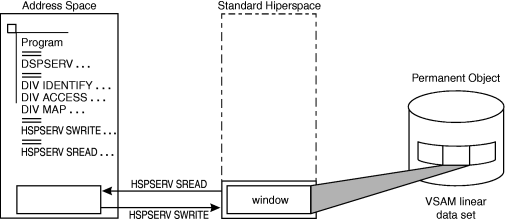 z/OS MVS Programming: Extended Addressability Guide
z/OS MVS Programming: Extended Addressability Guide
 z/OS MVS Programming: Extended Addressability Guide
z/OS MVS Programming: Extended Addressability Guide
|
Previous topic |
Next topic |
Contents |
Contact z/OS |
Library |
PDF
An example of mapping a data-in-virtual object to a hiperspace z/OS MVS Programming: Extended Addressability Guide SA23-1394-00 |
|
|
The following example shows how you would create a non-shared standard hiperspace with a maximum size of one gigabyte and an initial size of 4K bytes. Figure 1 shows the hiperspace with a window that begins at the origin of the hiperspace. Figure 1. Example of mapping a data-in-virtual object to a hiperspace
 Initially, the window in the hiperspace and the buffer area in
the address space are both 4K bytes. (That is, the window takes up
the entire initial size of the hiperspace.) The data-in-virtual object
is a VSAM linear data set on DASD.
The program can read the data in the hiperspace window to a buffer area in the address space through the HSPSERV SREAD macro. It can use the HSPALET parameter to gain faster access to and from expanded storage. The HSPSERV SWRITE macro can update the data and write changes back to the hiperspace. For an example of these operations, see Example of creating a standard hiperspace and using It. Continuing the example, the following code saves the data in the
hiperspace window on DASD and terminates the mapping.



|
 Copyright IBM Corporation 1990, 2014 Copyright IBM Corporation 1990, 2014 |